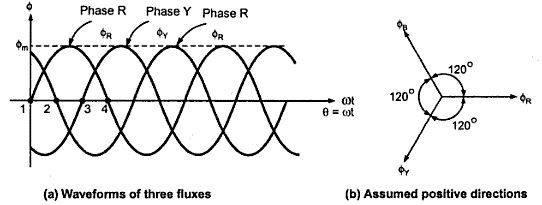Q.21 Which Induction motor has higher starting torque?
The slip ring motor has high starting torque as the resistance of the rotor winding is increased by adding external resistance to it. The starting torque is increased as the power factor of the rotor circuit gets improved during starting.
T= K* Flux* Rotor Current* Power Factor
Power factor = R/Z
=(Rotor winding Resistance+External Resistance)/Z
However, it is not possible to add external resistance to the rotor of the squirrel cage induction motor. The starting torque of the squirrel cage induction motor can be improved by the use of a double cage rotor.
When the motor is started the current flows through the upper cage winding which has more resistance. When the motor attains its base speed the most of the current flows through the lower cage of the motor.
Q.22 How rotating magnetic field produced in an induction motor?
The stator of an induction motor consists of a number of overlapping winding separated by an electrical angle of 120°. When the primary winding or stator is connected to a three-phase alternating current supply, it establishes a rotating magnetic field that rotates at a synchronous speed.

If we add the instantaneous value of the fluxes produced by phase voltages, the resultant flux in the motor is 1.5 times of maximum flux. The flux rotates in the same way as the ac supply rotates.
Q.23 How is the torque produced in 3 phase induction motor?
Each phase is connected to a coil that is allocated 120 degrees (geometrically speaking) with respect to the others. The rotating magnetic field induces EMF in the rotor. The rotor of the motor has short-circuited conductor and it leads to current in the rotor circuit. The rotor current interacts with the magnetic flux and produces torque. The rotor’s physical speed must be less than the rotating field speed, otherwise, no torque is produced.
Q.24 Why rotor Skewing is done in a squirrel cage induction motor?
The skewing is done to improve motor performance. The following are the advantages of rotor skewing.
- Increase of torque
- To decrease magnetic locking possibility
- To reduce the noise
Q.25 Why is external resistance added to the slip ring rotor of the induction motor?
The resistance added to the rotor of the induction motor increases the torque. Initially, higher value resistance is connected and the resistance is reduced as the motor accelerates towards its base speed.
Q.26 What are the advantages of the slip ring motor over the squirrel cage induction motor?
There are the following advantages of a slip ring motor.
- The external resistance can be added to the rotor circuit through slip rings and carbon brushes. Thus, it is possible to get higher starting torque.
- It is possible to control the speed of the motor with a slip power recovery system.
Q.27 Why is an induction motor called an asynchronous motor?
Asynchronous means – a + synchronous – Here a means not. The motor which does not run at the synchronous speed is called an asynchronous motor. For example, 4 pole induction motor has a synchronous speed of 1500 RPM. The rotor rotates at the speed of 1480 or 1470 but not at 1500 RPM. That is why the induction motor is called the asynchronous motor.
Q.28 What happens if rotor speed is equal to synchronous speed in an induction motor?
The rotor speed can not be equal to the synchronous speed of the induction motor. In the case of this, the torque is zero, and the motoring operation is not possible. The induction motor can’t run at synchronous speed.
Q.29 What is cogging?
The phenomenon of magnetic locking of stator and rotor is called cogging. Under the cogging condition, the motor refuses to start. The cogging phenomenon occurs when rotor slots are equal to stator slots.
Q.30 Why starter required for starting an induction motor?
The induction motor takes a high starting current at the start. To reduce the starting current starter is used.